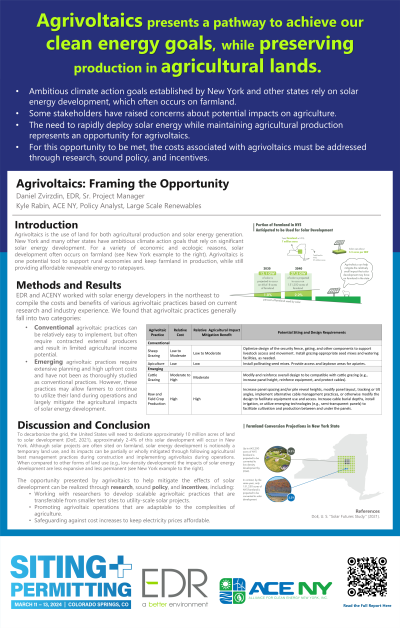Back

Solar Energy
Conversion of Farmland for Solar Development
Agrivoltaics: Framing the Opportunity
Tuesday, March 12, 2024
5:00 PM – 6:00 PM MT


Daniel Zvirzdin
Senior Project Manager
EDR
Albany, New York
Presenter(s)
Presentation Description: To address climate change, New York has enacted legislation that mandates generating 70% renewable electricity by 2030 and 100% zero-emission electricity by 2040. Many other states have enacted similar legislation. The ambitious goals that have been established rely on significant solar energy development. For a variety of economic and ecologic reasons, solar development often occurs on farmland. One potential tool to support rural economies and keep farmland in production while still providing affordable renewable energy to ratepayers is agrivoltaics. Agrivoltaics is the use of land for both agricultural production and solar energy generation.
Many states, including New York, have recently initiated policies and incentives to promote agrivoltaics, and various state-level working groups and organizations are actively shaping agrivoltaic policies and guidelines. Recognizing the potential benefits that agrivoltaics can provide, ACE NY and EDR recently released Agrivoltaics in New York: Framing the Opportunity, a report intended to support the conversation around agrivoltaics. This presentation extends the scope of that report and frames the opportunity presented by agrivoltaics more generally.
Agrivoltaics is a rapidly evolving field, and there is no one-size-fits-all approach. Solar developers, farmers, and policymakers will need to work collaboratively to ensure agrivoltaic practices can be implemented cost-effectively at both utility and community scales.
Many states, including New York, have recently initiated policies and incentives to promote agrivoltaics, and various state-level working groups and organizations are actively shaping agrivoltaic policies and guidelines. Recognizing the potential benefits that agrivoltaics can provide, ACE NY and EDR recently released Agrivoltaics in New York: Framing the Opportunity, a report intended to support the conversation around agrivoltaics. This presentation extends the scope of that report and frames the opportunity presented by agrivoltaics more generally.
Agrivoltaics is a rapidly evolving field, and there is no one-size-fits-all approach. Solar developers, farmers, and policymakers will need to work collaboratively to ensure agrivoltaic practices can be implemented cost-effectively at both utility and community scales.
